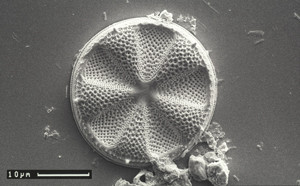ubiquitous oscillations² or about rhythmic structures of media
28 Jan - 07 Feb 2010
UBIQUITOUS OSCILLATIONS2 OR ABOUT RHYTHMIC STRUCTURES OF MEDIA
Eröffnung | Opening: Mi.| Wed. 27. Jan 2010, 19h00
Dauer | Duration: 28.1.-7.2.2010
Zeiten | opening times: Do | Thu - So. | Sun 14h00 - 20h00
listening and looking for a music theory of everyday life
In resonance with "OVERLAP – SOUND & OTHER MEDIA" the subject of this years CTM the exhibition will investigate into the rhythmic structures of every day media technology with two very contrasting sound-based installations. Our message is following: Sound is important for understanding media!
The first installation 2nd Order Diatoms (Akitoshi Honda & Shintaro Miyazaki) senses the rhythm of your mobile electronic gadgets, which you use in your daily life. The electromagnetic waves produced by the little machines get converted to sound and light. 2nd Order Diatoms is also a laser-installation, which creates circular patterns similar to some sort of diatoms, which are one of the oldest life forms of our earth. As artists we ask ourself: “How could LIFE FORM be synthesized?” Our answer: In the ancient ocean life form has began. In the ancient ocean there were many rhythms and frequencies, such as the waves of the ocean, vulcano’s furies and never ending thunders. They mixed each other and maybe effected to the forming of a new life form. We use the frequencies and rhythms of mobile phones to try to form new life forms. We call them “2nd Order Diatoms”.
The second installation Spiel-Tisch (Wolfgang Spahn & Thomas Gerwin) is an interactive audiovisual play table. There 12 different sound objects visualized in colorful circular patterns inspired by Chladni-Figures physical phenomena discovered in 1787 by Ernst Florens Friedrich Chladni. Spiel-Tisch is exploring sounds for the eye and thus provokes a new understanding of the visual from the point of "hear" by the ear.
Akitoshi Honda (*1977, Berlin / JP), Thomas Gerwin (*1955, Berlin), Shintaro Miyazaki (*1980, Berlin / CH / JP), Wolfgang Spahn (*1970, Berlin)
Eröffnung | Opening: Mi.| Wed. 27. Jan 2010, 19h00
Dauer | Duration: 28.1.-7.2.2010
Zeiten | opening times: Do | Thu - So. | Sun 14h00 - 20h00
listening and looking for a music theory of everyday life
In resonance with "OVERLAP – SOUND & OTHER MEDIA" the subject of this years CTM the exhibition will investigate into the rhythmic structures of every day media technology with two very contrasting sound-based installations. Our message is following: Sound is important for understanding media!
The first installation 2nd Order Diatoms (Akitoshi Honda & Shintaro Miyazaki) senses the rhythm of your mobile electronic gadgets, which you use in your daily life. The electromagnetic waves produced by the little machines get converted to sound and light. 2nd Order Diatoms is also a laser-installation, which creates circular patterns similar to some sort of diatoms, which are one of the oldest life forms of our earth. As artists we ask ourself: “How could LIFE FORM be synthesized?” Our answer: In the ancient ocean life form has began. In the ancient ocean there were many rhythms and frequencies, such as the waves of the ocean, vulcano’s furies and never ending thunders. They mixed each other and maybe effected to the forming of a new life form. We use the frequencies and rhythms of mobile phones to try to form new life forms. We call them “2nd Order Diatoms”.
The second installation Spiel-Tisch (Wolfgang Spahn & Thomas Gerwin) is an interactive audiovisual play table. There 12 different sound objects visualized in colorful circular patterns inspired by Chladni-Figures physical phenomena discovered in 1787 by Ernst Florens Friedrich Chladni. Spiel-Tisch is exploring sounds for the eye and thus provokes a new understanding of the visual from the point of "hear" by the ear.
Akitoshi Honda (*1977, Berlin / JP), Thomas Gerwin (*1955, Berlin), Shintaro Miyazaki (*1980, Berlin / CH / JP), Wolfgang Spahn (*1970, Berlin)

